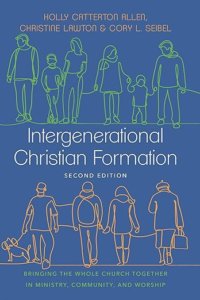
How can bringing different generations together in worship, learning, and community promote faith formation? Holly Allen discusses the benefits of a more intergenerational approach to ministry and strategies for helping young and old journey together in faith.
Listen on Apple Podcasts | YouTube Music | Spotify
Watch on YouTube
- Transcript — Click or Tap to Read
-
Announcer: Leading Ideas Talks is brought to you by the Lewis Center for Leadership of Wesley Theological Seminary in Washington, DC. Subscribe free to our weekly e-newsletter, Leading Ideas, at churchleadership.com/leadingideas.
Leading Ideas Talks is also brought to you by Healing Fractured Communities, a book written by alumni of the Lewis Center Community Leadership Fellows program. Each chapter paints a picture of the work of healing fractures like racism, education inequality, and poverty. Each chapter also includes takeaways to inspire healing in your community plus questions for reflection. All proceeds support the Dr. Lovett H. Weems Jr. Scholarship Fund. Learn more and order now at churchleadership.com/books.
How can bringing different generations together in worship, learning, and community promote faith formation? Holly Allen discusses the benefits of a more intergenerational approach to ministry and strategies for helping young and old journey together in faith.
Ann Michel: I’m Ann Michel. I’m a senior consultant with the Lewis Center for Church Leadership of Wesley Theological Seminary in Washington, D.C. I’m also one of the editors of our Leading Ideas e-newsletter. I’m pleased today to be the host for this episode of Leading Ideas Talks. My guest is Holly Allen, who teaches at Lipscomb University in Nashville in the areas of spiritual development and children’s and family ministry. She’s one of the authors of the book Intergenerational Christian Formation: Bringing the Whole Church Together in Ministry, Community, and Worship. The first edition of this book came out a little over a decade ago, and there’s a new edition, a second edition, that was published just last year. In reading this book, it is just so clear to me that you and your co-authors, Christine Lawton and Cory Seibel, bring just tremendous expertise and passion to this subject. So, I’m excited for the opportunity to talk with you today, Holly. Welcome to Leading Ideas Talks.
Holly Allen: Thank you for having me. It’s a delight to be here.
Ann Michel: So, your book makes a very strong case for bringing the generations together in worship and fellowship and learning and service. Yet in so many of our churches, this really isn’t the current practice. To set the stage for the conversation, I wondered if you could explain why the paradigm of age-specific ministries is so prevalent in North American churches.
Holly Allen: As your question intimates, it hasn’t always been so. Probably for 50 years or 55 years, probably in the 70s, we began dividing the generations. First, perhaps in youth ministry, then later in children’s ministry, and then we began to separate more and more. Probably the senior ministry came in next for the older people. Now we have singles ministries and we have emerging adult ministries or college ministries, those kinds of things. That has been the primary paradigm most churches have worked out of for a half century at least. The parents now in the pews, that’s all they’ve ever known. So, it’s a little bit hard to shift on them. So that’s been one of the hard things.
But how did we get here? Or why did we start separating? There were several reasons. I’m going to just go with three. Church growth strategists in the 70s and 80s were talking about “people like to be with people like themselves.” This really came out of India and the caste systems there. For missionaries there, it worked better for people to stay in with their own group. But it broadened fairly quickly. So, a lot of church growth people said, “Let’s do what they’re doing, what they’re advocating,” and that was one of the influences. Then the general cultural influence says, “Let’s put all the four-year-olds together. Let’s put all the 20-year-olds together. There was a move toward age segregation in society in general. When we were writing the first book, we went to a baseball game in California and I thought, “Oh, all the generations are here. This is so amazing.” But then I thought, “Oh, it shouldn’t be that amazing. That’s a sad commentary.” But we really are fairly age segregated across most of society. Churches are one of the few places that have been very intergenerational until the last few decades.
I would say what influenced me most when I was serving in the 1970s and 80s — I was the one who brought in children’s church at our church in the 80s—and I have repented of that. But I bought into the full developmental way of thinking about things, especially cognitive development. This was Piaget’s world, but it’s not his fault. We picked up on it and said, “Oh, this is a great theory. Why don’t we do this?” And as Ted Ward said, “Our theology for doing ministry has been developmental psychology.” Anyone can look at that and see there’s probably something wrong here.
We picked up on the idea that each segment needs to have only what they need cognitively, how they think. Little bitty children are intuitive thinkers, and you’ve got your concrete thinkers, and later you have your abstract thinkers. So, we shouldn’t do anything abstract for kids under, say 12, 13, 14. I bought that. I thought, “Oh my goodness! We shouldn’t have our children in the regular Sunday worship. We should be teaching them at their own level.” I was a teacher. I came from the world of educational psychology. It all made sense to me. But I didn’t run it past enough grids, nor did the people who were teaching me. So, I was probably in my 40s in the 1990s when I said, “Oh wait. Maybe cognitive development is not exactly the same as spiritual development.” I slowly began to unpack what I meant by that or what I thought about that. That teaching facts about the Bible is not the same as helping children and all of us come to know God. What does that mean? What does that look like? Of course it wasn’t just cognitive. We said teenagers really need different things than adults do. They’re grappling with hard thing—psychological, emotional, social needs, such as differentiation. Our 40 to 50-year-olds are not really into trying to separate from their parents. So, there are differences. And I acknowledge that. But they shouldn’t run the entire ministry system as they have. So, I think we just went too far down the developmental line.
The last factor I want to bring up is something that I’ve only been reading about just recently, and I should have figured this out sooner. But the marketing world has been in the business now at least for 30 or 40 years of saying “Your generation is unique. You have these needs. We have something special for you and just for you because you’re not like anybody else. You have unique needs.” I didn’t run my thinking past that—this is not in the book, I’ve just been reading about it recently. But we bought that individually. We said, “Oh yes, we’re unique. We need something for us.” But also, as churches, we’re [saying]“Our generations are so different. They don’t have really anything in common. We need to give them something special just for them. They’re so unique.” Yes, we’re all unique, but spiritually it’s really one journey.
Those of us who study spirituality in children, at first, we thought we were going to go with stage theory. We really come out saying spirituality is not quantitatively different, it’s not qualitatively different from a four-year-old to an 80-year-old. Now, an 80-year-old can maybe express themselves differently, and they can talk about what’s been happening spiritually more articulately than a four-year-old. But who’s to say the four-year-old has not been experiencing some of the same things? So, we’re coming to understand that even infants perhaps experience many spiritual things that they, of course, cannot exactly express. We’ve also broadened our understanding of what we mean by “spiritual.” It’s not simply “God/person.” It’s “person/self,” “person/others,” “person/God.” So, it’s a little broader. “Love the Lord your God with all your heart, soul, mind, and strength. And your neighbor as yourself.” This broadened our understanding. I think this last factor—that we’ve been sold a marketing strategy and we bought it personally, and then we bought it in churches—we can push back once we’re aware of that and look at our commonalities not our differences. So those are some of the reasons. I could talk a long time, but I will stop.
Ann Michel: Thank you for sharing that. That’s an extremely helpful perspective on understanding where we are. Your book identifies a number of benefits that are associated with an intergenerational approach to ministry including benefits that run the gamut of the different age spectrums. We don’t have time to talk about all of them, but I wondered if you might be able to just highlight a couple of the benefits that accrue from a more intergenerational approach to faith formation.
Holly Allen: Oh, I think a sense of belonging is probably one of the most important things. You can really belong to your youth group and just feel very welcome. Yet, when you go off to work or you move away after you graduate from high school, or go to college and you come back: that youth group is not there. So where do you belong? And there’s a sense that, “I don’t really belong here.” You might not have even ever worshiped with the whole body of Christ.
That sounds ridiculous, but it’s actually somewhat true if you had a youth group who did their own worship, and you had a children’s church before that. So, I think if you feel welcome in the whole body of Christ, then at whatever age you are, that will bless you. Belonging is one of those deep-seated needs that everybody has. So, I think that’s one of the big benefits psychologically, but I think that’s of God as well. The sense that these are my people, this is my village, this is where I belong.
Ann Michel: A sense of belonging to the whole community.
Holly Allen: All of us. It’s a little hard, especially in your larger churches, and that’s when we tend to say “we may need to find that sense of belonging in a smaller group within this body.”
There are people ahead of you that you can look at and say, “What does it look like to be a twenty-something single person, not married, and starting your career without a family? What does that look like? How do you follow Jesus?” That’s what high schoolers are asking. And college students are saying, “What does that next stage look like?” If you are in a church where everybody’s there, you can start saying, “Oh, I see. It can look like that.”
Ann Michel: So, there are models and mentors.
Holly Allen: There are models up and down. We get to join people on their spiritual journeys, all up and down. You aren’t just traveling your own little journey. You’re tapping into other people’s spiritual journeys, younger and older, and that is the most precious thing. It should be this way.
Ann Michel: I’ve read a lot of the literature around smaller churches and much of it really lauds the ability of small churches to provide an intergenerational experience in part because smaller churches often can’t really support the whole range of age specific ministries that a larger church can. That made me wonder, how can this take shape in churches of different sizes? I’m particularly interested in larger churches that are known for having such a broad array of different types and levels of ministry opportunities.
Holly Allen: That’s a big question that we run into every time we have “Intergenerate,” a big conference we hold every other year. Some megachurches will send their whole staff because they’re saying, “We’ve got to figure out this out.” Because they’ve led the way in saying, “Look, we have a fabulous children’s ministry. We have something for you. No matter where you are on the generational spectrum, we have something for you.” They can hire 50 people. They have 50 people to make sure that wherever you are in the journey, they have something for you. That’s actually a strength in many ways. By the way, hear me say this: I’m not against age specific ministry. It’s both/and. It’s not either/or, it’s a both/and. There are big things that happen in age-specific ministries that are harder to do in a cross-generational setting. So, I’m not against them. That’s a strength of megachurches, that they have something for everyone. They can run a whole special needs ministry that can really help those families. I just love that.
Generationally desegregating megachurches is a challenge. So, how can mega churches become more intentionally intergenerational? I’m going to give you a few ideas. The first thing I say is when you get your whole ministry staff together and you start talking about this, it takes a year or two for most everybody to even figure out what you’re talking about and how that might look for them. They’ve been hired to be the children’s minister or the youth minister or the senior minister. And they’re like, “We’re doing everything we can. It’s really going well. What? Everything I was trained to do you’re saying, no, we’re not gonna do that?” And of course, that’s not true. We’re not going to give it all up.
But, getting everybody on board first. The easiest way to become a little bit more intergenerational is to challenge every ministry to plan your next event and invite one more generation in. If the elementary school is doing something, invite the seniors. The oldest people. Or invite the emerging adults. They remember being kids, how fun is that? Just one more generation. Say, “Come join us. We would love to have you with us.” Almost any children’s minister, youth minister, senior minister can think, “Okay, which generation should we invite? How do we have to adapt? How do we need to adapt our event?” In other words, don’t invite the oldest people in church to your trampoline party. Plan an event that these two generations can do. That’s fairly easy and it’s usually very successful. That’s what you want to do. You want to have some successful cross-generational experiences to build on.

The book Healing Fractured Communities is written by alumni of the Lewis Center Community Leadership Fellows program who are pastoral leaders engaged in the work of renewal, resilience, and resistance in congregations, on college campuses, and in communities. Each chapter paints a picture of the work of healing fractures like racism, education inequality, and/or poverty. Each chapter includes takeaways to inspire healing in your community, and questions for reflection. Proceeds from the sale of the book support the Dr. Lovett H. Weems Jr. Scholarship Fund. Learn more and order now at churchleadership.com/books.
Ann Michel: Yeah, that’s a great idea for a first step. Your book is just so wonderfully accessible and yet it’s just packed full of research and information. You look at the biblical case for intergenerationality, you look at generational theory, you look at developmental theory, you survey the major sociological research that’s been conducted over the past couple of decades with children and youth. It all seems to point to the advantages of intergenerationality, which is wonderful. But I wondered, are there counter arguments? Where are the challenges and the obstacles, if this is such a logical conclusion of so many factors?
Holly Allen: It’s a really good question, and of course there are challenges. We try to frame them as challenges, not hindrances and barriers, but there are challenges. The ministers that are in our churches today were not trained on [intergenerationality]. So, just bringing the ministry staff on board, winning them to it, that’s a huge challenge when you’ve spent your whole life thinking of your ministry in a certain way. That’s probably the first challenge. If a whole church, if the leadership says, “I think we should do more of this,” you’ve got to get people with you. Again, you’ve got that fear that “they’re going to get rid of my job.” But, showing them that everybody needs to be part of a web or a network of relationships that includes peers and members of the other generations, and most people recognize that. So, the challenge is training our children, youth, and all the different kinds of ministers, small groups, education ministers, toward a more intergenerational approach. This is the biggest first challenge. And then the larger challenge is, how do you bring the church along? Most of the people in the pews have done separated ministries most of their lives.
So, this is deep, adaptive change. How do you gently lead those in the pew who have been generally content with at least this aspect of church? How do you adopt this new paradigm, this new way of being and thinking and behaving? So, for a church to adopt a whole intergenerational ethos, the church leadership, including the senior pastor and all the other ministries, need to have a really deep understanding and be committed to it.
It does take passionate, committed leadership to move toward becoming intentionally intergenerational. How does this come to this church? It’s often somebody who just got out of school, just got hired. They’re like, “Oh my goodness! We need to do this.” It’s so exciting, and all the senior people will go, “Oh, that’s so sweet. They’ve got a nice new idea. I hope they go do that somewhere.” But that’s not what it’s about. So, when one person brings an idea, it’s really hard to draw others in. So, it takes a whole team. If you’re just that one person, even if you’re the senior minister, you need a team. You cannot do it on your own. It just can’t be done on your own. So, you pull in the whole ministry staff. One at a time, if necessary, over a period of months. Then you find other advocates, those who are early adopters of new ideas. There’ll be people who go, “Oh, I’ve always thought that. I think that’s cool.” Bring them in, get them on that team so you have a lot of voices saying some of the same thing.
Probably the thing we do most poorly is we do not communicate well. We just say, “This is great. We’re going to do it. It’s going to be so good. Everybody’s going to love it.” Only they don’t even know what “it” is. You have to make a case for it. You don’t just get up and say, “we’re going to do this,” and everybody goes, “Yay, let’s do it.” It takes preparation, teaching, experiencing, exampling, doing some reading. I would say there’s a year transition of just moving toward it along the way, experiencing some very easy ways, as I mentioned earlier, of just inviting one more generation in without making a deal of it. Just saying we want to do this. Once people have experienced a little and they go, “That was nice. I like that.” Then they find out it’s not so weird.
Ann Michel: I think really what you’re describing is just change theory, regardless of what the change is in the church. The process that you just described is I think the way that change happens. You provide a lot of information on different practices that can be used in developing intergenerational ministry. Your book covers worship and small groups and learning and spiritual disciplines. I thought that was such an interesting thing to be thinking about how you practice the spiritual disciplines among the generations. But the idea that really stood out to me was the idea of storytelling as a vehicle of intergenerational ministry. So, I wanted to give you the opportunity to describe what that’s about, what it’s like, and why it’s an important piece of intergenerational faith formation.
Holly Allen: It may be the most central piece. I think we have lost generally the art of storytelling, and we certainly have rare opportunities to hear across the generations. As we mentioned earlier, I’m learning to live life under Jesus, and the best way is to hear from people who are a little further ahead on the journey. As someone said, “If you put all the 14-year-olds together, you’re going to have a Lord of the Flies culture.” You need all the generations. But we need to be hearing the stories of how you survived that horrific failure under God. Those are the stories you don’t hear very often.
So, hearing the stories of successes. How do you succeed as a CEO and follow God? How do you fail miserably? How do you survive bankruptcy? Divorce? How do you stay faithful to a child who has been utterly defiant, and has thrown everything in your face? You need stories from people who say, “This is how we are doing it now. This is what we tried. It didn’t work in our situation. It might in yours.” Hearing stories up and down the spectrum, and we need to hear our children’s stories. We tend to think “Well, after they’ve had some things happen, we can hear from them.” But their stories are as spiritually rich as ours. The needs they have. The fears they have. The struggles they have are just as important and we need to hear their stories and affirm that God is indeed at work in them, just as they described. It can be very encouraging for all of us. Storytelling is the one thing that I would say, “Just add it.” Find a way to add storytelling somewhere in all the ministries you have in some kind of intergenerational setting because we’re sharing our spiritual journeys and it’s important that we share them up and down the spectrum.
Ann Michel: One of the things I really loved about the book is at the very end, there’s an appendix, and I just loved it, because it was a list of 55 practical ideas for implementing intergenerational ministry. You’ve got ideas that run the gamut from sensory experiences and ways of approaching scripture study and worship and storytelling. I wondered if there’s something on that list of ideas for intergenerational ministry that’s a favorite of yours? And you could paint a picture for our listeners of what it looks like to do this.
Holly Allen: My favorite combines several of the things we’ve talked about. It has a little storytelling element. One of the things that we have found hard to do in any intergenerational setting is bring in scripture because we’re so convinced that it’s not going to work across the ages. But finding ways to do this, and this does, so I’m going to describe this one. It is called a “story “prompt.” I have done this exact story prompt many, many times. You take a passage and then you reframe it, and I’ll show you what I mean. First Samuel 17:37 says, “The God who delivered David from the paw of the lion and the paw of the bear, will deliver me.” When David is talking to King Saul, he says, “The God who delivered me from the paw of the lion, the paw of the bear, will deliver me from the hand of the Philistine.” That’s what he says to Saul. So, you take that, and you reframe it, and you ask the people in your small group or your class to finish this prompt: God who delivered David from the paw of the bear and the paw of the lion and from Goliath, is delivering me from… I used to say, delivered me from, and I realize most of us aren’t at the end yet. So, I say, delivering me.
I’ve got three or four stories, two sentence stories. These are all real stories.
A seven-year-old boy: God who delivered David from the bear and the lion and from Goliath has delivered me from my nightmares. My small group prayed over me, and every night I remember Psalm 4:8, and God has kept me from waking up in fear.
A 15-year-old girl: God who delivered David from the bear and the lion and from Goliath is delivering me, has delivered me from an abusive home situation. I am now in a safe place. God has made me safe.
Here’s one that is delivering. A 24-year-old-single woman: God who delivered David from the bear and the lion and from Goliath, is delivering me from hopelessness. I was trapped in a life of promiscuity, seeking from men what only God could give. As I have studied the word of God in the lives of Rahab, Esther, Tamar, Ruth and Deborah and Lydia and Mary, God is bringing me to a place of hope and peace. A place I thought I could never be.
There are a couple more stories about an octogenarian who was afraid of dying. The ways that God is at work, still delivering. Those are powerful stories, and they’re extraordinary people. So that’s one of my favorites. I’ve got several other prompts listed in the book that worked well in the past. And children are able to do this. They don’t say, “I don’t know what you mean.” They do know what you mean.
Ann Michel: Thank you. That’s really a powerful example. So, to bring this to a close I wanted to zoom the lens out a little bit and think about faith formation more broadly. I am not an expert in faith formation. Stewardship and leadership studies are my beat. But even I can observe enough to know that in a lot of churches, the time-tested approaches to faith formation–Sunday school classes, and worship attendance, and some of the things that we assumed were going to help form people in faith–they’re not quite as adequate to the challenges of our day as they used to be. I think a lot of ministry practitioners know this, but they don’t know what the new playbook is supposed to be. We’re in this liminal time, I think, when it comes to thinking about how the church is going to be able to form Christians for a new day. So, looking beyond the issue of intergenerationality, are there other trends you see in terms of faith formation in general?
Holly Allen: Yes. I grew up under a very cognitive approach. We just learned the stories. “Ten lepers. Jesus healed all ten. One came back and said, ‘thank you.’” And how are we supposed to act? We’re supposed to be grateful. But I learned the stories. I learned the books of the Bible and the verses. But I did not know that our purpose was to know who God is. I thought the end goal was to learn the Bible story. So, I’ve spent my adult life trying to sort out what we’re really after. I taught children and anybody else, the Bible, so they would know how to live. And now in the last 20 years, I’ve been teaching so people know God. That’s a different enterprise, and it’s a different enterprise across the whole spectrum. All the classes, as I was in adult in the Sunday school classes, they would do a whole bunch on context, and geography, and what the cultural trends were in that area. Not bad things. Then at the end, you’d read the verse or the chapter or whatever it was and say, “What do we need to get out of this?” We should have been saying, “Who is God? How is he calling us? What is he saying to us here?” Not just what does it say, but how is he calling us into this? Those are different questions, and I’ve seen now in the last few years that we’re shifting toward that. In the setting that I’m in, I’m helping to train new ministers to go that direction. I would say it looks a little bit more like spiritual disciplines.
But I think that churches in general are moving toward a more relational, more affective approach. But I want to stay hooked to scripture. Sometimes when we go down that relational, affective route, it’s all about “how do you feel?” and, “what’s your number on the Enneagram?” and, “how are you managing life?” Those are all perfectly appropriate questions, but we need to stay as close to scripture as we can because there’s no other place in our life where we do that.
Ann Michel: I want to thank you for this conversation. It’s been fascinating. I can’t say enough about the book. Again, it’s Intergenerational Christian Formation: Bringing the Whole Church Together in Ministry, Community, and Worship. I want to thank you and your coauthors for providing such a really great resource, and thank you for this wonderful conversation today.
Holly Allen: Thank you, Ann. Thanks for inviting me. It’s been delightful to be with you.
Announcer:Thank you for joining us for Leading Ideas Talks.
Don’t forget to subscribe to our free weekly e-newsletter, Leading Ideas, to be notified when new episodes are published. Visit churchleadership.com/leadingideas.
 Intergenerational Christian Formation: Bringing the Whole Church Together in Ministry, Community, and Worship, Second Edition. (Intervarsity Press, 2023) by Holly Catterton Allen, Christine Lawton, and Cory L. Seibel is available at Intervarsity Press, Cokesbury, and Amazon.
Intergenerational Christian Formation: Bringing the Whole Church Together in Ministry, Community, and Worship, Second Edition. (Intervarsity Press, 2023) by Holly Catterton Allen, Christine Lawton, and Cory L. Seibel is available at Intervarsity Press, Cokesbury, and Amazon.
Related Resources
- Intergenerational Ministry for the Post-pandemic Church by Doug Powe
- Why Making Your Church Multigenerational Is Worth the Effort by Chuck Lawless
- Intergenerational Ministry and the Small Church by Brandon J. O’Brien
Photo by laterna magica on Lightstock.





